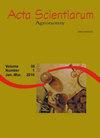Precrops and N-fertilizer impacts on soybean performance in tropical regions of Brazil
IF 1.2
4区 农林科学
Q3 AGRONOMY
引用次数: 4
Abstract
Precrops have different growth patterns, nitrogen (N) requirements, and production of residues varying in amounts and quality that may affect the N-clycling and the soybean (Glycine max L. Merrill) cropped in succession. This study aimed to evaluate the effect of precrops and N fertilization on soybean performance. An experiment was conducted in Londrina, Paraná State, Brazil, with six precrops treatments: fallow, ruzigrass (Urochloa ruziziensis), showy rattlebox (Crotalaria spectabilis), corn (Zea mays) without or with 80 kg ha−1 of N at topdressing as urea, and wheat (Triticum aestivum). Subplots consisted of two levels of N fertilization at soybean sowing: 0 and 30 kg ha−1 of N as ammonium nitrate at sowing. Urochloa ruziziensis as precrops increased the soybean yield (5,171 kg ha-1) when compared with corn (4,346 kg ha-1) and fallow (4,467 kg ha-1). In 2016/17, N fertilization of soybean with 30 kg ha−1 of N at sowing, although increasing the initial plant growth (745 kg ha-1 with vs. 662 kg ha-1 without), impairs nodulation (100 mg pl-1 with vs. 130 g pl-1 without) and does not increase grain yield. Oil and protein concentrations in soybean grains are not influenced by precrops and N fertilization at sowing. We found that the use Urochloa ruziziensis as cover crop in soybean precrops is a good recommendation option in tropical regions of Brazil, because increasing the yield of soybean grown in succession. N fertilization at in soybean sowing it should not be recommended even in the presence of a large amount of straw.巴西热带地区作物前茬和氮肥对大豆生产性能的影响
预茬作物具有不同的生长模式、氮素需要量以及不同数量和质量的残茬产量,这些都可能影响氮素循环和大豆(Glycine max L. Merrill)的连作。本试验旨在评价作物预施和施氮对大豆生产性能的影响。在巴西帕拉纳州的Londrina进行了6个作物前处理:休耕、穗草(Urochloa ruziziensis)、响尾草(Crotalaria spectabilis)、玉米(Zea mays)和小麦(Triticum aestivum)。大豆播期施氮量分别为0和30 kg ha,其中1为硝铵。与玉米(4,346 kg ha-1)和休耕(4,467 kg ha-1)相比,ruziziensis作为前茬作物可提高大豆产量(5,171 kg ha-1)。在2016/17年度,播种时施氮量为30 kg hm -1的大豆,虽然促进了植株的初始生长(施氮量为745 kg hm -1,施氮量为662 kg hm -1),但不利于结瘤(施氮量为100 mg hm -1,施氮量为130 g hm -1),且不能提高籽粒产量。大豆籽粒中油脂和蛋白质含量不受作物前施肥和播期施氮的影响。研究发现,在巴西热带地区,使用褐藻作为大豆前茬覆盖作物是一个很好的推荐选择,因为它可以提高大豆的产量。大豆播期即使有大量秸秆,也不建议施氮。
本文章由计算机程序翻译,如有差异,请以英文原文为准。
求助全文
约1分钟内获得全文
求助全文
来源期刊

Acta Scientiarum. Agronomy.
Agricultural and Biological Sciences-Agronomy and Crop Science
CiteScore
2.40
自引率
0.00%
发文量
45
审稿时长
>12 weeks
期刊介绍:
The journal publishes original articles in all areas of Agronomy, including soil sciences, agricultural entomology, soil fertility and manuring, soil physics, physiology of cultivated plants, phytopathology, phyto-health, phytotechny, genesis, morphology and soil classification, management and conservation of soil, integrated management of plant pests, vegetal improvement, agricultural microbiology, agricultural parasitology, production and processing of seeds.
 求助内容:
求助内容: 应助结果提醒方式:
应助结果提醒方式:


